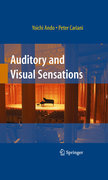
Ando establishes a theory of subjective preference of the sound field in a concert hall, based on preference theory with a model of human auditory-brain system. The model uses the autocorrelation function and the interaural crosscorrelation function for signals arriving at two ear entrances and considers the specialization of human cerebral hemispheres. The theory may be applied to describe primary sensations such as pitch or missing fundamental, loudness, timbre, and duration. These four primary sensations may be formulated by the temporal factors extracted from the autocorrelation function associated with left hemisphere. Spatial sensations such as localization in the horizontal plane, apparent source width, and subjective diffuseness are described by spatial factorsextracted from the interaural crosscorrelation function associated with the right hemisphere. Unique combination of architectural acoustics, psychophysics,neurophysiology, and auditory modeling First scientific proposal of commonalities between analogous auditory and visual sensations Comprehensive neuronal signal processing model of spatial hearing Rational theory of the architecturalacoustical design of performance spaces based on psychoacoustics of hearing and listener preferences INDICE: From the contents Part I Temporal and Spatial Sensations in the human auditory system. Introduction. Analysis of Temporal Factors of a Source Signal and Spatial Factors of a Sound Field. Subjective Preference of the Sound Field. Electronic and Magnetic Responses in the Central Auditory System. Central Auditory Signal Processing Model and Temporal and Spatial Factors. TemporalSensations of the Sound Signal. Spatial Sensations of the Binaural Signals. Applications (I) – Music and Concert Hall Acoustics. Applications (II) – SpeechIdentification (SI) in the Sound Field. Applications (III) – Method of Noise Measurement and Examples. Applications (IV) – Annoyance of Noise. Appendix: Sound coordinator as a specialist for each concert hall.- Part II Temporal and Spatial Sensations in the Human Visual System. Introduction to Visual Sensations.
- ISBN: 978-1-4419-0171-2
- Editorial: Springer
- Encuadernacion: Cartoné
- Páginas: 360
- Fecha Publicación: 01/08/2009
- Nº Volúmenes: 1
- Idioma: Inglés
